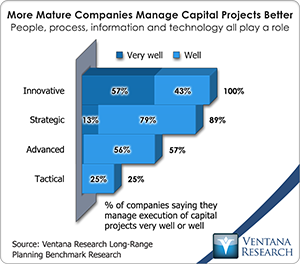Ventana Research recently completed an in-depth benchmark research project on long-range planning. As I define it, long-range planning is the formal quantification of the more conceptual strategic plan. It makes specific assumptions and expresses in numbers how a company expects its strategy will play out over time. Almost all (95%) of those participating in the research see a need to make improvements to their long-range planning process.
Ventana Research recently completed an in-depth benchmark research project on long-range planning. As I define it, long-range planning is the formal quantification of the more conceptual strategic plan. It makes specific assumptions and expresses in numbers how a company expects its strategy will play out over time. Almost all (95%) of those participating in the research see a need to make improvements to their long-range planning process. The research shows that one useful improvement is integrating long-range planning with the budgeting process. Today, many corporations confine their long-range planning to a high-level, less detailed extension of their current budget. Our research shows that companies that incorporate individual capital projects and major business initiatives as discrete elements of the long-range plan get better results. Marrying the high-level business outlook with the more significant bottom-up investment details produces better results.
Incorporating specific projects and initiatives into the long-range planning process has been common in companies in project-centric industries, including engineering and construction, aerospace and shipbuilding. Pharmaceutical and other long-cycle businesses that need to plan their major investments also have made specific projects and initiatives explicit parts of their forward-looking projections. Doing so allows drug companies, for example, to map out the transition from late-stage trials to post-approval so they can lay out the details needed for sales, production and distribution, and understand the financial consequences of these actions. The success of early-stage drugs is hit-and-miss, and because the actual timing of approval in various jurisdictions is difficult to forecast, pharmaceutical companies need to be able to revise near-term and long-range plans on an ongoing basis. Yet many other types of businesses can benefit from a more detailed approach to long-range planning that incorporates major initiatives and capital spending projects. Doing so offers a competitive advantage for shorter-cycle businesses that need to manage rapidly evolving products in dynamic markets. Asset-intensive businesses that must plan and execute capacity growth and heavy maintenance programs will also gain from greater integration of capital project details in their long-range plans.
Our research found that there are differences among companies in the degree to which they explicitly integrate planning for capital projects and major corporate initiatives into their long-range financial plans. Only one-fourth of organizations participating in the benchmark research report that their strategic plans are highly integrated with the management of individual projects. A majority – 61 percent – has some degree of integration of the two, and 10 percent say they’re not integrated at all. We cross-tabulated companies’ assessments of the quality of their long-term planning processes with the degree of integration of capital projects and major initiatives and found a positive correlation. That integration results in a better process: Nearly all (85%) of those with a highly integrated process say theirs works well or very well, compared to 63 percent that have a somewhat integrated process and just 22 percent that have not integrated these at all. The research demonstrates that there is a positive correlation between the degree of integration and the quality of alignment of long-range planning with a company’s strategy. The results were similar to the previous point: Nine out of 10 that have a highly integrated process also create long-range plans that are well-aligned with strategy, compared to seven out of 10 that have a somewhat integrated approach, and just one-third where there is no integration.
The research also found a correlation between the maturity of a  company’s long-range planning process and its ability to manage the execution of projects and initiatives. Our analysis of long-range planning practices finds the majority (62%) of organizations participating in our research concentrated at the second and third levels of our four-part hierarchy. One-fourth are at the lowest Tactical level while only one in nine have reached the highest Innovative level. More mature companies are those that have a well-designed process, one that explicitly includes initiatives and projects. In addition, they also manage data more effectively, limit their use of spreadsheets and have clear strategic direction from senior executives, among other traits. The cumulative impact of all of these positive qualities is evident in better management of these strategically important and resource-intensive activities. All of the Innovative companies are able to manage the execution of their projects and initiatives well or very well, while nine out of 10 of Strategic companies are able to do so. By contrast, only 57 percent of the Advanced companies and only one-fourth of the Tactical companies are able to handle their execution well. Achieving better outcomes from strategic and long-range planning starts with including key details about projects in the process, yet companies can achieve even better results with a concerted effort to address shortcomings in the people, information and technology elements of strategic and long-range planning.
company’s long-range planning process and its ability to manage the execution of projects and initiatives. Our analysis of long-range planning practices finds the majority (62%) of organizations participating in our research concentrated at the second and third levels of our four-part hierarchy. One-fourth are at the lowest Tactical level while only one in nine have reached the highest Innovative level. More mature companies are those that have a well-designed process, one that explicitly includes initiatives and projects. In addition, they also manage data more effectively, limit their use of spreadsheets and have clear strategic direction from senior executives, among other traits. The cumulative impact of all of these positive qualities is evident in better management of these strategically important and resource-intensive activities. All of the Innovative companies are able to manage the execution of their projects and initiatives well or very well, while nine out of 10 of Strategic companies are able to do so. By contrast, only 57 percent of the Advanced companies and only one-fourth of the Tactical companies are able to handle their execution well. Achieving better outcomes from strategic and long-range planning starts with including key details about projects in the process, yet companies can achieve even better results with a concerted effort to address shortcomings in the people, information and technology elements of strategic and long-range planning.
Organizations – even those that think they’re doing an adequate job – should reexamine their long-range planning to identify where they need improvements. Companies, especially those with more than 100 employees, that don’t do formal long-range planning need to begin the process. Going through the motions of planning is better than nothing, but our research indicates a connection between more mature long-range planning practices and achieving superior results.






